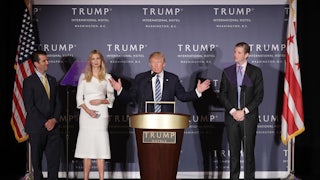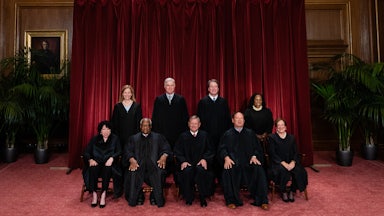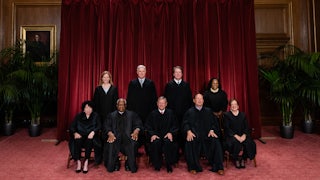Earlier this month, former President Donald Trump asked the Supreme Court to intervene on his behalf in the litigation surrounding the federal probe into classified documents that were stored at Mar-a-Lago after he left office. His lawyers claimed that “any limit on the comprehensive and transparent review of materials seized in the extraordinary raid of a President’s home erodes public confidence in our system of justice.”
The Supreme Court apparently disagreed. Last week, only a day after the last filing deadlines had passed, the justices rejected Trump’s plea out of hand with no recorded dissents. It’s hard to read too much into the justices’ decision since it came without explanation like most similar orders. And yet, within 48 hours of the high court’s ruling, the Justice Department appealed the entirety of Judge Aileen Cannon’s order imposing a special master on the investigation to the Eleventh Circuit Court of Appeals.
Justice Department lawyers appear to have recognized what Trump and his legal team seem to have missed: The Supreme Court almost never rules in his favor in personal disputes and only occasionally sided with him on policy matters when he was president. Though the court’s conservative wing is now firmly in control of its docket and rulings, it has only rarely handed significant victories to Trump. And yet the former president and his legal team never seem to tailor their expectations accordingly.
The latest defeat came last week as part of Trump’s effort to undermine the investigation into classified documents stored at Mar-a-Lago after he left the White House last year. Trump and his lawyers convinced Cannon, whom he had appointed to the bench in 2020, to block the Justice Department from using any of the seized evidence and appoint a special master to oversee the privilege claims. The ruling was widely criticized for, among other things, appearing to favor a former president’s claim of executive privilege against the executive branch itself.
Among Cannon’s many critics was the Eleventh Circuit Court of Appeals. The Justice Department had appealed part of Cannon’s order that blocked investigators from reviewing the classified documents it had seized during the Mar-a-Lago search. Prosecutors argued that their review was necessary not only for the criminal investigation but also for the review of what classified materials were out of the government’s control and the possible damage they could have done. The three-judge panel, which included two judges appointed by Trump, ruled in favor of the Justice Department.
Trump’s misunderstanding isn’t completely baseless. In recent years, and especially after Trump took office, the Supreme Court has handed more than a few victories to conservatives and Republicans. Federal courts can no longer hear partisan-gerrymandering lawsuits. The Second Amendment generally protects a right to carry firearms in public. Federal agencies have a harder time issuing regulations to address climate change. The Occupational Safety and Health Administration can’t mandate vaccines or masks for most workplaces in America during a pandemic. States can pass restrictive voting laws without fearing challenges under the Voting Rights Act. Roe v. Wade is no longer the law of the land.
But those victories have only rarely extended to Trump himself when they did not directly overlap with the GOP’s goals or with movement conservatism’s agenda. Trump and many of his allies may see these things as indistinguishable, of course. But most of the Supreme Court justices, whose conservative members come from an intellectual and philosophical tradition that predates Trumpism, apparently do not.
The clearest example came in 2020 when Trump sought to stop two parallel investigations. In Trump v. Vance, the then president had hoped to quash a grand jury subpoena as part of a criminal inquiry into his businesses by Cyrus Vance Jr., Manhattan’s district attorney at the time. In Trump v. Mazars, Trump also hoped to block a congressional subpoena into his financial records that a committee said it needed for a variety of legislative and oversight purposes. The two cases reached the Supreme Court at the same time and were heard on the same day.
Supreme Court lawyers often build their arguments around points to which they think the justices will be most receptive. If a lawyer thinks that the justices will be friendly to their case—if they represent, say, a religious person with a Free Exercise Clause claim or a state trying to carry out an execution—then they may be more inclined to swing for the fences. If, on the other hand, they think that the Supreme Court might be divided on the issue based on past rulings or on intuitive understandings of each justice, they might make a narrower argument that could appeal to more skeptical members of the court.
Trump’s lawyers, for reasons known only to them, made claims that most of the justices could not stomach. One of them, Jay Sekulow, argued in Vance that any criminal process that touched the president was unconstitutional, a point that even the Justice Department arguing on behalf of the Trump administration did not make. That argument was resoundingly rejected by all nine justices, including the two justices who dissented from the court’s decision in Vance’s favor on narrower grounds. Trump did score a partial victory in the Mazars case, where the justices laid out a balancing test for congressional subpoenas of a president’s personal information, but he only succeeded in running out the clock until his term ended.
On policy issues, the Supreme Court also rejected some of the Trump administration’s major initiatives when the process that led to them was sloppy or deceptive. Some of these defeats were narrower than others. The court rejected the Trump administration’s bid to place a citizenship question on the 2020 census only when Chief Justice John Roberts broke ranks with his fellow conservatives, citing evidence that the Justice Department’s stated rationale for adding the question was a lie. Roberts also joined with the court’s four liberals at the time to defeat Trump’s bid to rescind the Deferred Action for Childhood Arrivals program because the administration had not properly followed the Administrative Procedures Act.
Trump’s misconception may have come from the earliest major case from his presidency that reached the Supreme Court. In Trump v. Hawaii, the Trump administration sought to implement the third iteration of its travel ban that mostly targeted Muslim-majority countries after numerous defeats in the lower courts. The Supreme Court ruled in a 5–4 decision that the ban was a valid exercise of Trump’s executive powers over immigration and brushed aside evidence that it was an attempt to impose the Muslim ban that Trump had proposed on the campaign trial. That ruling largely fell within typical conservative legal thinking on executive power and national security. But Trump may have seen it as a sign that the conservative justices would ultimately back him over less friendly judges in the lower courts.
In this regard, he was badly mistaken. And over time, some of those in his inner circle would learn the same hard lesson. In the weeks leading up to January 6, 2021, Trump and his allies tried to get the Supreme Court to intervene in the 2020 election in his favor. Lower courts had resoundingly rejected his efforts to overturn the election results and raise baseless claims of voter fraud. In December 2020, the state of Texas filed an unusual lawsuit directly before the Supreme Court that sought to block Pennsylvania and five other states that Biden had won from certifying their electors. Sidney Powell, one of the pro-Trump lawyers at the time, was recorded saying that she and her associates hoped that Justice Samuel Alito would use one case to delay the certification process and help their cause.
The Supreme Court took no steps to help them, however. In Texas v. Pennsylvania, the justices rejected the case, with Alito and Justice Clarence Thomas writing separately to briefly say they would have granted the petition to hear the case on procedural grounds and then deny relief. And Alito himself took no steps to block the certification of electoral votes before or on January 6. He even denied one petition as moot on the day after the violence on Capitol Hill.
Naturally, this is not to say that the Supreme Court will never come to Trump’s aid. Its upcoming decision in Moore v. Harper later this term on the independent state legislature theory could open the door to election-related malfeasance by Trump-friendly officials in the states in 2024. And the conservative justices may yet rule in his favor, albeit indirectly, in some litigation about voting rules during the next presidential election, as they did in 2020. But on other efforts to hold him accountable, the justices have shown no interest in sticking their necks out for the guy who appointed one-third of them. How long it will take Trump to notice this remains to be seen.










